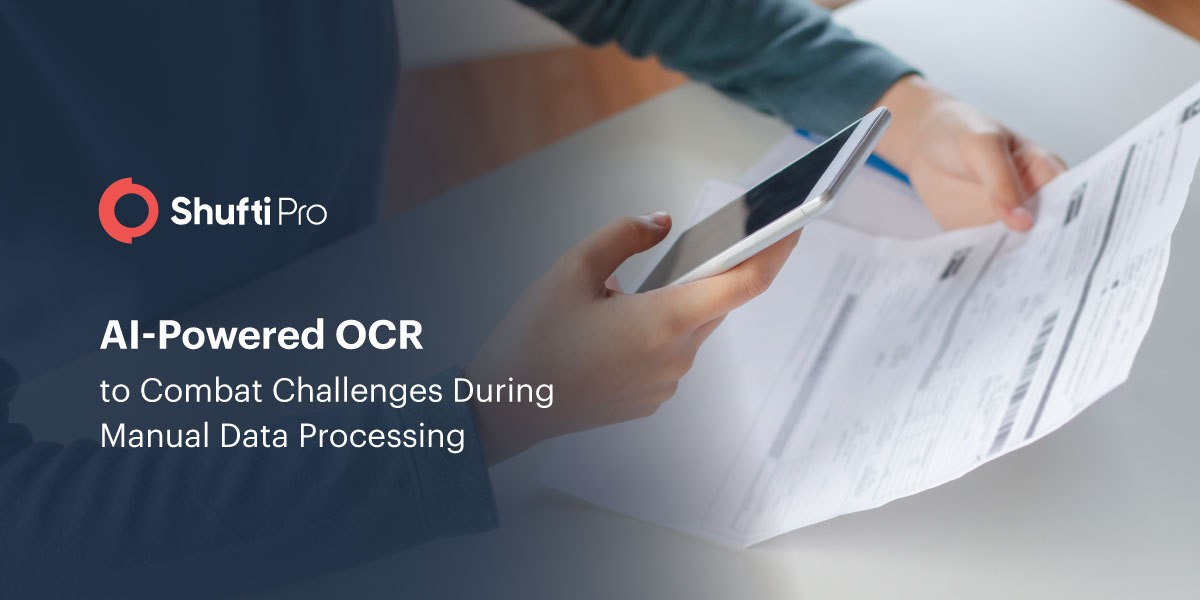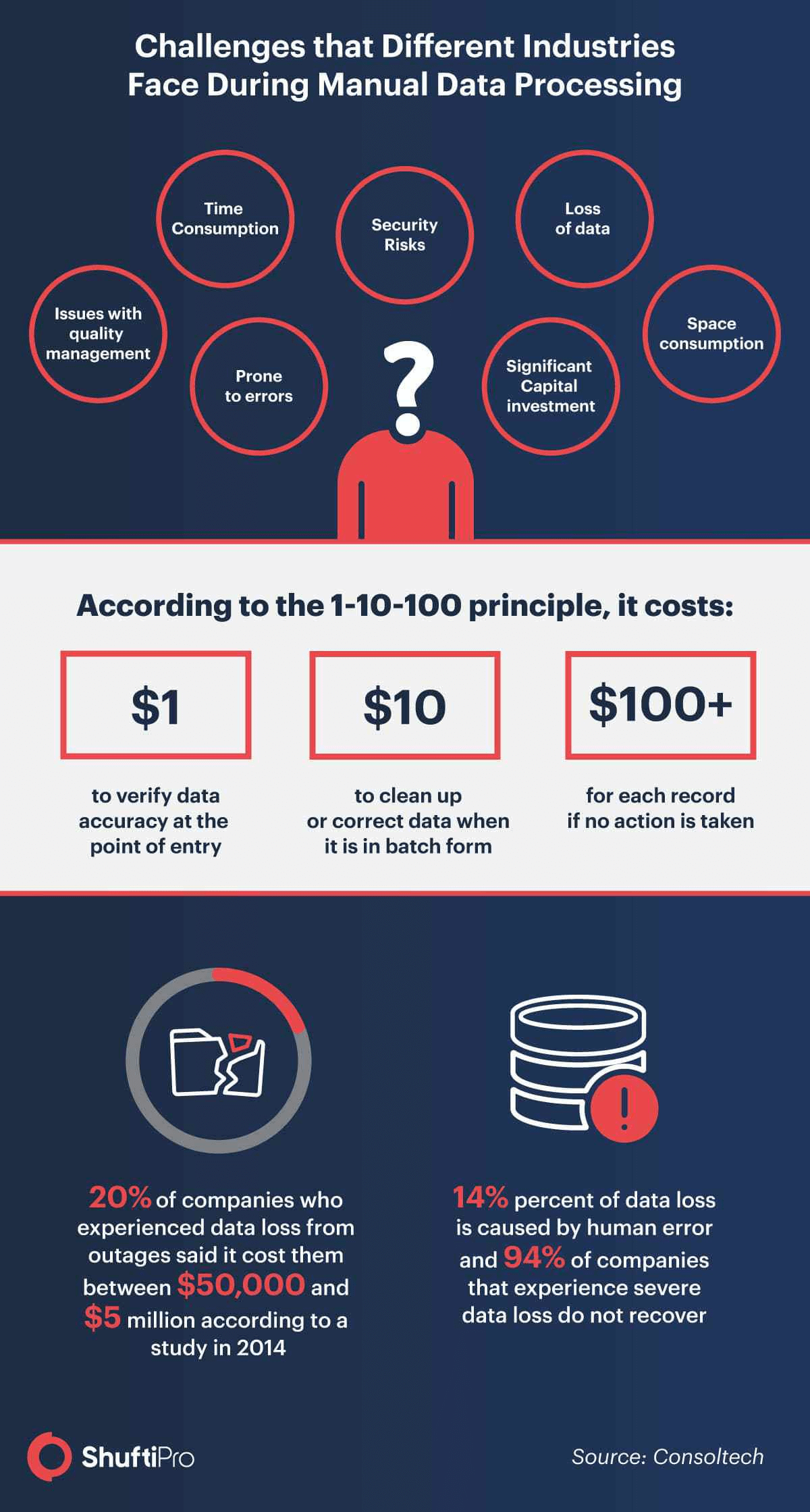AI-Powered OCR to Combat Challenges During Manual Data Processing

Every industry has to deal with tons of customer data on a daily basis. Receiving information, extracting important values, converting it into machine-friendly language, and making it readily available for further processing sounds easy, but it is not a piece of cake. It takes days to complete the entire process which is not only time-consuming but also demands a lot of money and effort. Today’s fast-moving environment needs a solution to eliminate manual data processing so that companies can save time, money, and effort.
For instance, the identity verification sector can no longer consider manual data processing for its services. The ‘know your customer’ verification and anti-money laundering screening are two hectic jobs that can take days for completion per verification. If a financial institution performs thousands of end-user verifications, how can the service provider authenticate so many documents without compromising the quality of the process? It is nearly impossible to onboard customers with the manual methods of data entry and processing. The industries need an efficient solution that can ease the procedure.
We conducted a small survey to know how manual methods of data processing are increasing challenges for the industry leaders, and the responses were overwhelming. Read this blog to find out what the challenges industry leaders are facing with manual data processing and how we can help them.
Thoughts of Industry Leaders on Manual Data Processing

Multiple companies contributed to our survey explaining the challenges they face during manual data processing and here’s what they have experienced.
The CMO of Crediful, Lucas Robinson, says, “The biggest setback of manual data processing is the fact that it consumes a lot of time. When entering information manually, it takes up a lot of time, no matter how fast one can type or process information, it will never be as fast as it needs to be. Typing a lot of information can be complex and cause people to lose focus and this will also add to the time it takes for data entry. Not being quick enough leads to a big delay in data availability.”
Undoubtedly, the excessive time consumed is the biggest hassle that an organisation has to face and there is not enough time for the employees to spend in processing big data every day.
Apart from the time consumed, Lewie Mortier, Financial analyst and trader at Mitrade has shared his inconveniences during manual data processing and reported, “A challenge faced by using manual documents is that it takes a lot of space. As your business grows, you will have to find a room to store the documents and can be a downfall if you have a small office or want to save on space.”
Although cloud storages are the best way of storing data, manual processes consume a lot of space than usual. Companies have to settle the extracted data separately and the final files have to be saved as well. Furthermore, fixing the errors again needs some space.
Financial challenges are tough to combat and manual data processing can take up a lot of money for your company, Jacob Johnson from Symbium shared his view of the traditional processing and said, “Obtaining, maintaining, and managing that data is possible but requires a significant capital investment. In case of customer onboarding, forms and workflows should be present at a minimum level and need *not* contain any AI capabilities. However, forms and workflow tools on their own are insufficient to address complex regulatory requirements and legal analyses that form the promise of AI tech. Streamlining those complex regulatory and legal analyses in customer onboarding is possible but requires a novel approach in order to curtail the mammoth task of solving these problems through machine learning.”
Saving costs is essential but if organisations continue to go for the traditional methods of processing data, it may not be possible. Businesses need an AI-powered solution that can save costs, time, and effort as well.
Did you know that errors in manual data processing are higher and can cost companies a fortune? Also, the security of confidential information is at risk. Here’s what Adriene Raynott, Sr. Business Analyst at Cogneesol has to say,
“When you manually file paper documents, the chances of errors and losing essential documents are increased. This can also lead to wastage of time, money, and efforts. Business documents contain sensitive information that needs to be held securely. With manual processes, you might be putting valuable data at risk as anyone can access it.”
It’s no surprise that data breaches have increased in the past few years. Manual processes give fraudsters a clear path to fulfil their malicious intent. He further added to his statement and said, “As we do multiple edits on documents, paperwork is not amendable to be changed, after each modification, the final version needs to reprint that confuses employees about the documents’ real version. So, the wastage of time and effort makes employees feel stressed.”
AI-Powered OCR – The Perfect Solution
Optical Character Recognition (OCR) has been in action since 1990 but it is not as effective as it should be for the fast-moving world. When Artificial Intelligence is there to enhance all the operations in the highly technological world, why not improve OCR? AI-powered optical character recognition is the new normal that can enhance data entry and processing for all the industries. Be it a law firm that needs to process documents for a case or a foreign exchange firm that has to verify documents for onboarding a trader, AI has revamped the data processing method.
What is AI-Powered OCR?
An AI-powered optical character recognition (OCR) can extract data from a variety of document types, languages, and handwritten documents. The traditional OCR has to be fed with algorithms in order to process different document types. Otherwise, there is only one document type that can be checked. With artificial intelligence algorithms, the OCR software can self-learn and process documents without human intervention.
The process of data processing with AI-powered OCR is completed in three stages:
- Preprocessing
- Data extraction
- Pot-processing
Learn about the three stages in detail: AI-Powered OCR to replace data entry in 2020 – A detailed insight
Shufti’s AI-Powered ‘OCR for Business’ Solution
Processing customer data is a tough job if your business is following the traditional methods. It will consume time and effort along with a lot of capital investment. Furthermore, employee productivity decreases since the manual process requires several edits to eliminate errors. The industry leaders shared their perspectives regarding manual data processing and fortunately, Shufti has a solution to combat these challenges. An OCR software powered by Artificial Intelligence is a great way of processing data and ensuring its efficacy as well. It only takes 15 to 60 seconds for the software to extract and process data, and provides more than 90 per cent accuracy. Moreover, Shufti’s OCR technology provides a global coverage for 150+ languages.
Get in touch with our experts to know more details about OCR for business.










